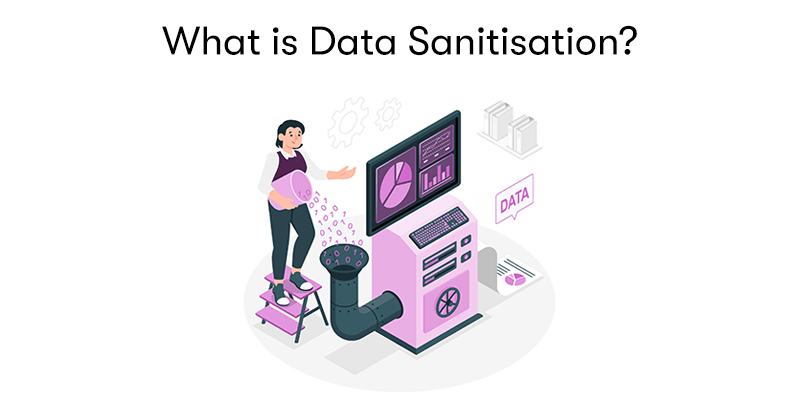What is Data Sanitisation?
Welcome to our comprehensive exploration of Data Sanitisation, a pivotal concept in the realm of information security and privacy. In an age where digital data is akin to currency, its protection and proper disposal have become paramount.
Data sanitisation isn't just about deleting files; it's a meticulous process of permanently and irreversibly erasing data from storage devices, ensuring it cannot be recovered. This practice is crucial for safeguarding sensitive information from unauthorised access, especially when repurposing or discarding electronic devices.
As we delve deeper, we will unravel the importance, methods, and processes of data sanitisation, highlighting its significance in today's data-driven world.
What is Data Sanitisation?
Data sanitisation refers to the process of deliberately, permanently, and irreversibly removing or destroying the data stored on a memory device to ensure that it can't be recovered. This process is crucial in various contexts, mainly when dealing with sensitive or confidential information. Here are some key aspects of data sanitisation:
Security
The primary goal of data sanitisation is to prevent unauthorised access to sensitive data, especially when disposing of or repurposing electronic devices like hard drives, SSDs, smartphones, and laptops.
Methods
Common methods of data sanitisation include:
- Physical destruction (like shredding a hard drive).
- Degaussing (using strong magnets to disrupt the magnetic field of a storage medium).
- Overwriting (writing new data over the old data, multiple times).
Compliance
Many industries have regulations and standards that mandate data sanitisation to protect consumer information. For instance, health and financial services often require strict data disposal procedures.
Difference from Deletion or Formatting
Unlike simple file deletion or disk formatting, which often leaves data recoverable, sanitisation ensures the data can't be retrieved with any data recovery tools.
Environmentally Friendly
Proper data sanitisation can also be environmentally friendly, as it allows for safely recycling or repurposing of electronic components once the data has been securely erased.
Data sanitisation is essential to data security and privacy, especially in an era where data breaches are a significant concern. It ensures that when devices are discarded, sold, or repurposed, the data they once contained is no longer accessible or recoverable.
Why is Data Sanitisation Important for Businesses?
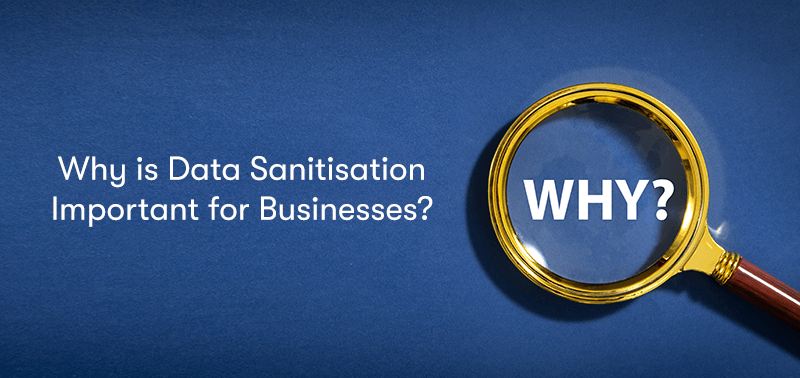
Data sanitisation is critically important for businesses for several reasons, most of which revolve around protecting sensitive information and compliance with legal and regulatory standards. Here's why it is crucial:
Protection of Sensitive Information
Businesses often handle sensitive data, including customer information, financial records, employee details, and trade secrets. Sanitisation ensures that this information is destroyed and cannot be recovered when devices are retired or repurposed, protecting against data breaches and identity theft.
Compliance with Regulations and Laws
Many industries are subject to strict data protection and privacy laws, such as GDPR in Europe, HIPAA in the healthcare sector in the U.S., and various state-level data breach laws. Non-compliance can result in substantial fines, legal penalties, and reputational damage.
Preventing Data Breaches
Even data on devices no longer in use can be a source of data breaches. Proper data sanitisation prevents unauthorised access to data on such devices, reducing the risk of a breach.
Maintaining Customer Trust
In an era where data privacy is a significant concern for consumers, businesses must demonstrate their commitment to data security. Effective data sanitisation practices can help maintain and enhance customer trust and brand reputation.
Corporate Espionage Protection
By securely sanitising data, businesses can protect themselves against corporate espionage, where competitors might seek to obtain confidential information.
Cost-Effective Data Management
Properly sanitising data helps in efficient data management, reducing the risk of storing redundant or outdated data, which can incur additional storage costs.
Environmental Responsibility
Data sanitisation allows for the safe disposal or recycling of electronic components, aligning with corporate social responsibility initiatives for environmental sustainability.
Risk Management
It forms a crucial part of a company's risk management strategy by mitigating risks associated with data leaks and ensuring business continuity.
Data sanitisation is not just a technical necessity; it's a critical business practice that impacts legal compliance, security, reputation, and overall risk management. As data breaches become more common and costly, and as privacy laws become more stringent, the importance of data sanitisation will only continue to grow.
What Devices Hold Data That Needs Sanitisation?
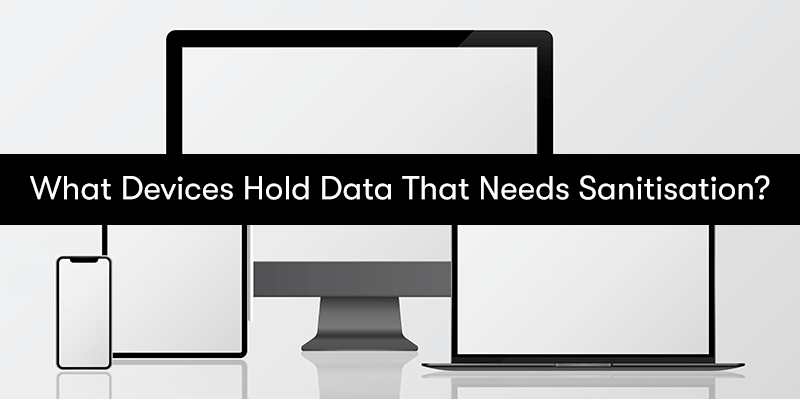
Data that needs sanitisation can be stored on a wide variety of devices. Businesses and individuals alike must be aware of all the potential devices that can hold sensitive data. Here's a list of common devices that often require data sanitisation:
Hard Disk Drives (HDDs)
Used in computers, servers, and some older laptops. HDDs can store large amounts of data, which remains recoverable even after deletion or formatting.
Solid State Drives (SSDs)
Common in modern laptops, desktops, and servers. SSDs use a different technology than HDDs, requiring specific sanitisation techniques due to their wear-levelling algorithms.
Mobile Devices
Smartphones and tablets often contain sensitive personal and business data, including contacts, messages, emails, and documents.
USB Flash Drives and External Hard Drives
Portable storage devices are widely used for data transfer and backup. They can be easily lost or stolen, making data sanitisation essential when they are no longer in use.
Memory Cards
Memory cards can hold significant amounts of data in cameras, smartphones, and other devices.
Network Attached Storage (NAS)
Often used by businesses for centralised data storage, NAS devices can contain sensitive company data.
CDs and DVDs
Although less common now, these optical media formats can still hold sensitive data and require physical destruction for proper sanitisation.
Digital Cameras and Camcorders
These devices have internal memory and/or memory cards that can hold personal or sensitive data.
Printers and Copiers
Modern printers and copiers often have internal storage that retains copies of printed, scanned, or faxed documents.
Point of Sale (POS) Systems
Used in retail and hospitality, POS systems can store transaction data, including potentially sensitive customer information.
Wearable Technology
Devices like smartwatches and fitness trackers can store health data, location history, and other personal information.
Embedded Systems and IoT Devices
Internet of Things (IoT) devices, including smart home gadgets, medical devices, and industrial machinery, often store operational data that may be sensitive.
It's important to note that the methods of data sanitisation may vary depending on the type of device and the nature of its storage media. Some devices, like SSDs and mobile devices, require specific approaches due to their unique architectures. As technology evolves, staying informed about how and where data is stored is essential for effective data sanitisation practices.
What Types of Data Might Need to be Sanitised?
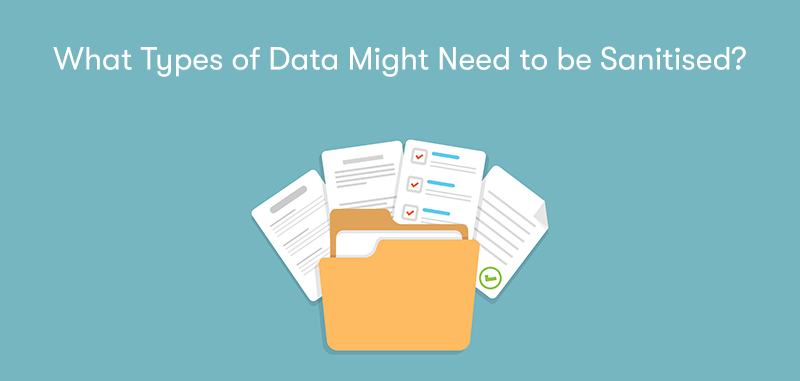
Data sanitisation is necessary for a wide range of data types, especially those that are sensitive, confidential, or could pose a risk if accessed by unauthorised individuals. Here are some key types of data that typically require sanitisation:
- Personal Identifiable Information (PII): This includes names, addresses, social security numbers, dates of birth, and other information that can be used to identify individuals. PII is sensitive and often targeted by cybercriminals.
- Financial Information: Credit card numbers, bank account details, transaction history, and financial statements are prime targets for theft and fraud.
- Health Records: Patient information, medical histories, treatment records, and insurance data, particularly protected under laws like HIPAA in the U.S.
- Corporate Information: Business plans, financial reports, market analysis, and other confidential business documents.
- Intellectual Property: Patents, trademarks, copyrights, trade secrets, and proprietary technology or product designs.
- Employee Data: Personal details of employees, performance evaluations, payroll information, and HR files.
- Customer Data: Customer databases, contact lists, purchase histories, and preferences.
- Emails and Correspondence: Business and personal emails can contain a wealth of sensitive information.
- Legal Documents: Contracts, legal communications, and any documents related to litigation or legal inquiries.
- Research Data: Data related to scientific, market, or academic research, which might be proprietary or sensitive.
- Educational Records: Student records, including grades, disciplinary actions, and personal information.
- Government Records: Data related to government operations, citizen information, and classified materials.
- Operational and Logistical Data: Information about business operations, logistics, manufacturing processes, and supply chain details.
- Digital Credentials: Usernames, passwords, and other authentication data.
- Software and Source Code: Proprietary software, source code, and related digital assets.
It's important to note that the need for data sanitisation extends beyond just deleting these types of data. Sanitisation ensures that the data is completely destroyed and unrecoverable, a critical step in protecting against data breaches, identity theft, and complying with various data protection regulations.
What Are Some Methods of Sanitising Data?
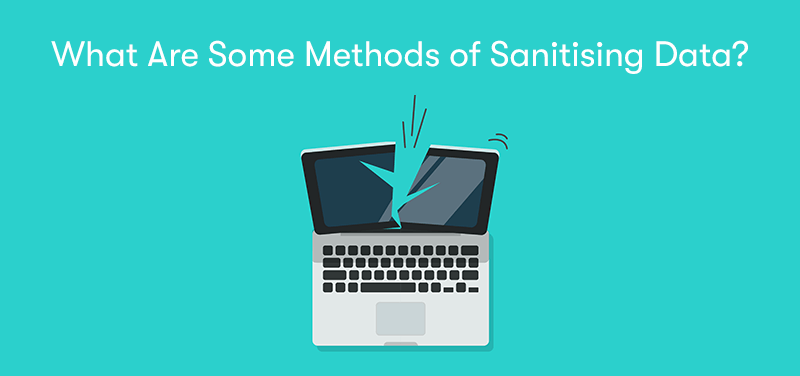
Data sanitisation can be achieved through various methods, each suitable for different types of storage media and data sensitivity levels. Here are some common data sanitisation methods:
Physical Destruction
Shredding: Similar to paper shredders, specialised shredders can physically destroy hard drives, CDs, DVDs, and other storage devices.
Degaussing: This process uses a high-powered magnet to disrupt the magnetic field of a storage device, making the data unreadable. It's effective for magnetic media like hard disk drives.
Incineration and Melting: Exposing storage devices to extremely high temperatures to melt or incinerate them renders the data unrecoverable.
Overwriting (Data Wiping)
This involves writing new data over the existing data, often multiple times. Various software tools are available for this purpose, each following different standards (like the DoD 5220.22-M standard) which dictate how often the data should be overwritten.
Cryptographic Erasure
This method encrypts all data on a storage device and then destroys the encryption key. Without the key, the data becomes inaccessible and effectively useless.
Factory Reset
Common in smartphones and tablets, a factory reset is designed to wipe all user data from the device. However, it's important to note that the effectiveness of a factory reset can vary, and it may only sometimes be as thorough as other methods.
Formatting
While regular formatting isn't always sufficient for complete data sanitisation (as it often leaves data recoverable), some forms of advanced formatting, like full formatting or secure formatting, can be more effective.
File Shredding Software
These specialised software tools can securely delete individual files from your computer, overwriting the data so it can't be recovered.
Each method has its advantages and disadvantages and is suitable for different scenarios. For instance, physical destruction is very effective, but it also means the storage device can't be reused. Overwriting and cryptographic erasure allow the storage media to be reused, but they require more time and can be less feasible for large volumes of data.
It's important to choose the suitable method based on the data type, the storage medium, compliance requirements, and if the device will be reused. In many cases, these methods may be employed for enhanced security.
What is the Process of Data Discovery for Sanitisation?
The process of data discovery for sanitisation is a critical step in ensuring that all sensitive data is identified and appropriately handled. This process typically involves several key stages:
Identification of Data Storage Devices
The first step is to identify all devices that may contain sensitive data. This includes not only obvious devices like servers, laptops, and desktop computers but also less obvious ones like smartphones, tablets, USB drives, external hard drives, backup tapes, and even printers or copiers with internal storage.
Inventory and Documentation
Create a detailed inventory of these devices. It is crucial to document their type, location, usage, and the nature of data they are likely to contain. This documentation will serve as a guide throughout the sanitisation process.
Data Mapping
This involves understanding where different types of data are stored within your organisation. Data mapping should cover structured data (like database contents) and unstructured data (like files on a network drive or emails).
Classification of Data
Not all data require the same level of sanitisation. Classify data based on its sensitivity and the applicable regulatory requirements. For example, personally identifiable information, financial records, and health information often require stricter sanitisation methods.
Risk Assessment
Assess the risk associated with each type of data. Higher-risk data, which would cause more damage if breached, may require more stringent sanitisation methods.
Selecting Appropriate Sanitisation Methods
Based on the data classification and risk assessment, decide on the most appropriate sanitisation methods for each data type or device. This could range from overwriting and encryption to physical destruction.
Execution of Sanitisation
Carry out the sanitisation process according to the chosen methods. Ensure that the process is thorough and complies with any relevant legal or regulatory standards.
Verification and Certification
After sanitisation, it's important to verify that the data has indeed been irrecoverably destroyed. In some cases, especially in highly regulated industries, you might need to provide certification or reports from third-party verification to confirm that the sanitisation has been completed correctly.
Update Inventory and Documentation
Once sanitisation is complete, update your inventory and documentation to reflect the actions taken. This serves as a record of compliance and can be crucial for audits.
Ongoing Monitoring and Review
Data discovery and sanitisation is not a one-time process. Regular reviews and monitoring are essential to ensure new data is identified and handled appropriately, and to adapt to any changes in the regulatory landscape or business operations.
This process is integral to data security and regulatory compliance, and it helps minimise the risk of data breaches and the potential legal and reputational consequences that can follow.
Final Notes on Data Sanitisation
In conclusion, data sanitisation is essential for maintaining data security and compliance in today's digital landscape. This process, crucial for businesses and individuals alike, involves permanently erasing sensitive data from various devices, ranging from hard drives and mobile devices to more unexpected sources like printers and IoT devices.
We've explored the various methods of data sanitisation, including physical destruction, overwriting, and encryption, each suited to different types of data and devices. Data discovery is pivotal to identifying and classifying data for effective sanitisation. By implementing thorough data sanitisation strategies, organisations can protect against unauthorised data access, ensure compliance with stringent data protection laws, and maintain the trust of their customers and stakeholders.
Remember, responsible data handling is key to operational integrity and security in the digital world.


